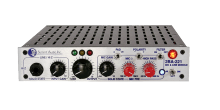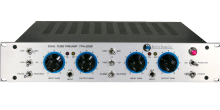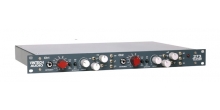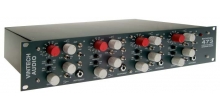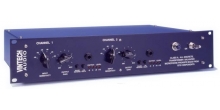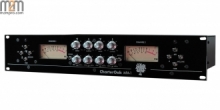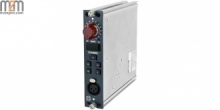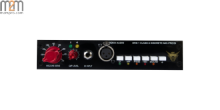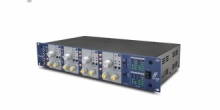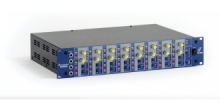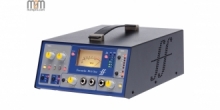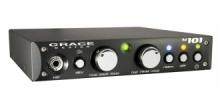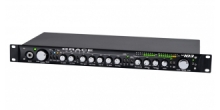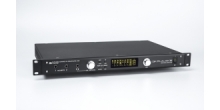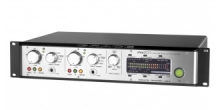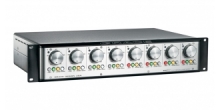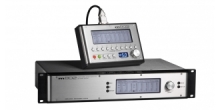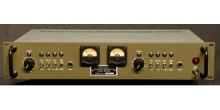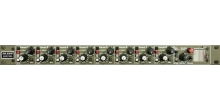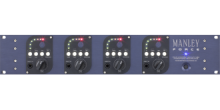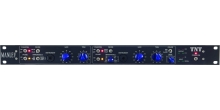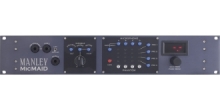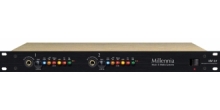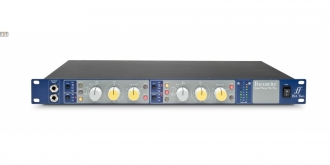 Agrandir l'image
Agrandir l'image
Front panel, per channel
- 1/4" instrument input
- Variable input impedance - Low, ISA 110, Medium, High
- Input selection - Mic, Line, Instrument
- 0 - 30 dB/30 - 60 dB gain switch
- Phantom power switch
- Phase invert switch
- 0 - 60 dB gain in 10 dB steps
- 0 - +20 dB continuously variable trim
- Variable high-pass filter with on/off switch
- Insert point on/off switch
- Eight-LED user-calibrated level meters
- Single power switch
Rear panel, per channel
- XLR-F mic inputs
- 1/4" TRS line inputs
- 1/4" TRS Sends
- 1/4" TRS Returns
- XLR-M line output
- Single peak meter calibration dial
- Single IEC power socket
Maximum Input and Output Levels
| Maximum Output Level | +24 dBu with a THD+N < 0.01% at 1kHz measured with 150 Ω source impedance and 22Hz/22kHz band-pass filter |
| Maximum Microphone Transformer Input Level | +7 dBu with a THD+N < 0.7% at 1kHz measured at 0 dB of gain with 150 Ω source impedance and 22Hz/22kHz band-pass filter |
Mic Input Response
| Gain range | 0 dB to +60 dB in 10 dB steps, plus 0 dB to +20 dB continuously variable trim | |
| Input Impedance | Switched Impedance setting Equivalent Input Impedance at 1 kHz |
Low = 600 Ω ISA 110 = 1.4 kΩ Med = 2.4 kΩ High = 6.8 kΩ |
| EIN (Equivalent Input Noise) | Measured at 60 dB of gain with 150 Ω source impedance and 22 Hz-22 kHz band pass filter | -127 dB |
| Noise | Noise at output with unity gain (0 dB) and 22 Hz-22 kHz band pass filter | -97 dBu |
| Signal-to-Noise Ratio | Measured with 150 Ω source impedance and 22 Hz-22 kHz band pass filter | 121 dB relative to max output +24 dBu |
| Total Harmonic Distortion + Noise | Measured with a -20 dBu input signal at +30 dB of gain and with a 22 Hz-22 kHz band pass filter | < 0.0007% at 1 kHz |
| Frequency Response | At minimum gain (0 dB) | -0.5 dB at 10 Hz, -1 dB at 135 kHz, relative to 1 kHz |
| At +60 dB gain | -6 dB at 10 Hz, -1 dB at 115 kHz, relative to 1 kHz | |
| CMRR (Common Mode Rejection Ratio) | -94 dB for mic input at 60 Hz for max. output = +24 dBu -91 dB for mic input at 10 kHz for max. output = +24 dBu |
|
| Crosstalk Channel to Channel | Mic input, with I/P = 0 dBu, gain = 0 dB @ 1 kHz input to channel A, channel B output = -85 dB |
Line Input Response
| Gain range | -20 dB to +10 dB in 10 dB steps, plus 0 dB to +20 dB continuously variable trim | |
| Input Impedance | 10 kΩ from 10 Hz to 200 kHz | |
| Noise | Noise at main output with gain at unity (0 dB) measured with 50 Ω source impedance and a 22Hz - 22 kHz band pass filter | -97 dBu |
| Signal-to-Noise Ratio | Measured with 50 Ω source impedance and a 22 Hz-22 kHz band pass filter | 121 dB relative to max output +24 dBu |
| Total Harmonic Distortion + Noise | Measured with a 0 dBu input signal, +10 dB of gain and a 22 Hz-22 kHz band pass filter | < 0.0002% at 1 kHz |
| Frequency Response | At minimum gain (0 dB) | -0.3 dB at 10 Hz, -1 dB at 80 kHz, relative to 1 kHz |
| Crosstalk Channel to Channel | Line input, with I/P = 0 dBu, gain = 0dB @ 1 kHz input to channel A | Channel B output = -91 dB |
Instrument Input Response
| Gain range | +10 dB to +40 dB continuously variable trim | |
| Input Impedance | 2 MΩ | |
| Noise | Measured with 22 Hz-22 kHz band pass filter | Minimum gain (+10 dB) = -95 dBu |
| Frequency Response | At minimum gain (+10 dB) | -0.1 dB at 10 Hz, -1 dB at 115 kHz, relative to 1 kHz |
| At maximum gain (+40 dB) | -2.5 dB at 10 Hz, -1 dB at 110 kHz, relative to 1 kHz |
High-Pass Filter
| Roll-Off | 18 dB per octave (3 pole filter) |
| Frequency Range | Continuously variable from 16 Hz to 420 Hz (-3 dB) |
Weight and Dimensions
| W x D x H | 480 mm x 280 mm x 44 mm |
| Weight | 3.7 kg |
FOCUSR607T
Nouveau
FOCUSRITE - ISA TWO

You may only need a couple of mic preamps – but they should be the best
The ISA Story goes back to 1985, when Sir George Martin commissioned legendary designer Rupert Neve to design new modules for the console at AIR Montserrat. They were so successful that more were commissioned for AIR London. These original modules form the basis of today’s Focusrite ISA range – delivering the legendary Focusrite sound to leading studios, artists, producers and engineers around the world. Literally hundreds of hits have been made with the Focusrite ISA Range – and continue to be made today.
Two legendary mic pres
Focusrite’s ISA Two brings together a totally independent pair of legendary ISA microphone preamps from the original ISA 110 module, combining the best of traditional solid-state electronics with the original input transformer specified by Rupert Neve – the Lundahl LL1538. Two is a nice round number – ideal for recording, say, a vocal and an instrument, or a stereo piano. But though you may only need two mic pres, you owe it to your craft to choose the best. (And if you need more, we offer ISA 428 Mk II 4-channel and ISA 828 8-channel units too.)
Variable input impedance
We’ve made one little adjustment to the mic pre. The original ISA 110 had a single input impedance that was ideal for the mics of the time. We’ve added three more, allowing you to get the very best out of any microphone, vintage or modern. Give a vintage mic the input it expects to get a traditional, warm sound. Pair the ISA Two with modern microphones and get the most transparent sound imaginable. Or experiment and pull out the inner character of any microphone you care to try. Couple that with up to 80dB of gain and you can be ready for anything.
Front panel instrument inputs
In addition to the mic pres, there are front panel instrument inputs for instant access, along with rear-panel line ins. There’s also a balanced insert point on the rear panel, actuated with a front-panel button so you can insert the EQ, dynamics or other processors you need. Add to that the user-calibrated 8-LED metering and variable cutoff high-pass filter and you know that with the ISA Two you’ll have everything you need to get the highest quality sound into your recordings.
Key Features
Lundahl LL1538 mic input transformer
Rupert Neve originally chose the Lundahl LL1538 to be the input transformer on the ISA 110. To this day the Lundahl transformer remains the best microphone input transformer available, and is used in every ISA Series mic pre. Rupert Neve also perfected the Zobel network found in the ISA circuit; something which takes a lot of knowledge and a golden set of ears.
Up to 80 dB of gain
ISA Two offers up to 80 dB of clean, distortion-free gain. The much heralded ISA topology also ensures low noise, even at the highest gain levels. The transformer alone supplies 20 dB of gain, while ISA's input stage offers up to 60 dB in addition, giving an astonishing 80 dB of maximum gain on the microphone input.
Variable input impedance
Four choices of input impedance, including the original ISA 110 value, allow you to match the preamp to your microphone, even if it's a vintage type, giving you the best possible sound. The impedance is selected using a switch on the front panel, and the impedance choice is remembered even once the unit is switched off and back on.
User-calibrated metering
Each channel has an eight-LED array to clearly display the level of your two signal. You can line up your analogue levels with your converters of DAW by using the calibration knob on the rear panel. You will be safe in the knowledge that you have avoided clipping on the way in.
Front panel instrument and rear panel line inputs
Two 1/4in. jack sockets on the front panel of ISA Two give you instant access to a transparent DI input. TRS line inputs are available on the rear panel too, and you can step through them instantly to select the one you want.
Variable cut-off high-pass filter
Built in, and easily accessed with its own large knob an illuminated button, is an extremely smooth sounding 18dB/octave high-pass filter of the same design as the original ISA 110 module. This is ideal for cutting out rumble, thumps and other unwanted low-frequency sounds and with a range of 16 to 420 Hz, it's easy to lose what you don't want, and keep what you do.
Rear panel balanced inserts
Each channel of ISA Two has its own balanced insert point. With 1/4in. TRS send and receive connections, your choice of signal processor can be connected and switched in and out using the illuminated switch on the front panel.
Features And Specs
Front panel, per channel
- 1/4" instrument input
- Variable input impedance - Low, ISA 110, Medium, High
- Input selection - Mic, Line, Instrument
- 0 - 30 dB/30 - 60 dB gain switch
- Phantom power switch
- Phase invert switch
- 0 - 60 dB gain in 10 dB steps
- 0 - +20 dB continuously variable trim
- Variable high-pass filter with on/off switch
- Insert point on/off switch
- Eight-LED user-calibrated level meters
- Single power switch
Rear panel, per channel
- XLR-F mic inputs
- 1/4" TRS line inputs
- 1/4" TRS Sends
- 1/4" TRS Returns
- XLR-M line output
- Single peak meter calibration dial
- Single IEC power socket
Maximum Input and Output Levels
| Maximum Output Level | +24 dBu with a THD+N < 0.01% at 1kHz measured with 150 Ω source impedance and 22Hz/22kHz band-pass filter |
| Maximum Microphone Transformer Input Level | +7 dBu with a THD+N < 0.7% at 1kHz measured at 0 dB of gain with 150 Ω source impedance and 22Hz/22kHz band-pass filter |
Mic Input Response
| Gain range | 0 dB to +60 dB in 10 dB steps, plus 0 dB to +20 dB continuously variable trim | |
| Input Impedance | Switched Impedance setting Equivalent Input Impedance at 1 kHz |
Low = 600 Ω ISA 110 = 1.4 kΩ Med = 2.4 kΩ High = 6.8 kΩ |
| EIN (Equivalent Input Noise) | Measured at 60 dB of gain with 150 Ω source impedance and 22 Hz-22 kHz band pass filter | -127 dB |
| Noise | Noise at output with unity gain (0 dB) and 22 Hz-22 kHz band pass filter | -97 dBu |
| Signal-to-Noise Ratio | Measured with 150 Ω source impedance and 22 Hz-22 kHz band pass filter | 121 dB relative to max output +24 dBu |
| Total Harmonic Distortion + Noise | Measured with a -20 dBu input signal at +30 dB of gain and with a 22 Hz-22 kHz band pass filter | < 0.0007% at 1 kHz |
| Frequency Response | At minimum gain (0 dB) | -0.5 dB at 10 Hz, -1 dB at 135 kHz, relative to 1 kHz |
| At +60 dB gain | -6 dB at 10 Hz, -1 dB at 115 kHz, relative to 1 kHz | |
| CMRR (Common Mode Rejection Ratio) | -94 dB for mic input at 60 Hz for max. output = +24 dBu -91 dB for mic input at 10 kHz for max. output = +24 dBu |
|
| Crosstalk Channel to Channel | Mic input, with I/P = 0 dBu, gain = 0 dB @ 1 kHz input to channel A, channel B output = -85 dB |
Line Input Response
| Gain range | -20 dB to +10 dB in 10 dB steps, plus 0 dB to +20 dB continuously variable trim | |
| Input Impedance | 10 kΩ from 10 Hz to 200 kHz | |
| Noise | Noise at main output with gain at unity (0 dB) measured with 50 Ω source impedance and a 22Hz - 22 kHz band pass filter | -97 dBu |
| Signal-to-Noise Ratio | Measured with 50 Ω source impedance and a 22 Hz-22 kHz band pass filter | 121 dB relative to max output +24 dBu |
| Total Harmonic Distortion + Noise | Measured with a 0 dBu input signal, +10 dB of gain and a 22 Hz-22 kHz band pass filter | < 0.0002% at 1 kHz |
| Frequency Response | At minimum gain (0 dB) | -0.3 dB at 10 Hz, -1 dB at 80 kHz, relative to 1 kHz |
| Crosstalk Channel to Channel | Line input, with I/P = 0 dBu, gain = 0dB @ 1 kHz input to channel A | Channel B output = -91 dB |
Instrument Input Response
| Gain range | +10 dB to +40 dB continuously variable trim | |
| Input Impedance | 2 MΩ | |
| Noise | Measured with 22 Hz-22 kHz band pass filter | Minimum gain (+10 dB) = -95 dBu |
| Frequency Response | At minimum gain (+10 dB) | -0.1 dB at 10 Hz, -1 dB at 115 kHz, relative to 1 kHz |
| At maximum gain (+40 dB) | -2.5 dB at 10 Hz, -1 dB at 110 kHz, relative to 1 kHz |
High-Pass Filter
| Roll-Off | 18 dB per octave (3 pole filter) |
| Frequency Range | Continuously variable from 16 Hz to 420 Hz (-3 dB) |
Weight and Dimensions
| W x D x H | 480 mm x 280 mm x 44 mm |
| Weight | 3.7 kg |




